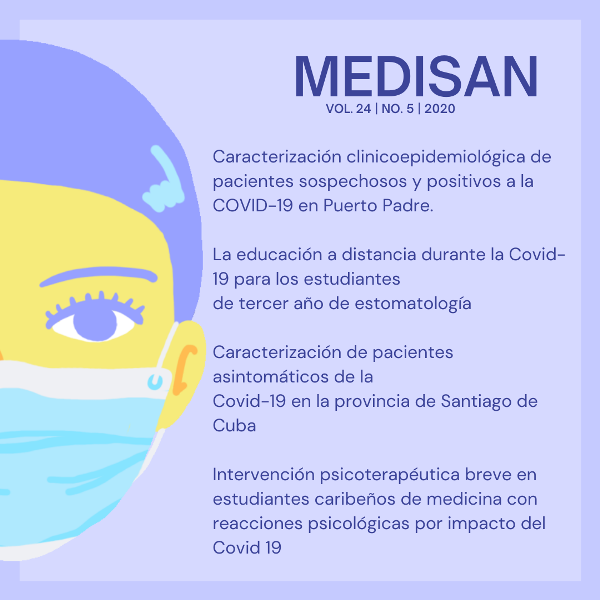Clinical epidemiological characterization of suspected and positive patients to COVID-19 in Puerto Padre
Keywords:
Coronavirus, SARS-CoV-2, COVID-19, epidemiology.Abstract
Introduction: The COVID-19 is an emergent disease that has affected everybody in a pandemic way, with high sanitary, economic and social costs.
Objective: To characterize suspected and positive patients to COVID-19 according to selected clinical epidemiological variables.
Methods: An observational, descriptive and cross-sectional study of 565 patients, assisted in the municipality of Puerto Padre, Las Tunas, was carried out from February to May, 2020. The information was obtained from the epidemiological surveys. The following variables were analyzed: incidence, age, sex, health area, case definition, infection source, clinical forms, result of the RT-PCR, symptoms and signs, comorbidities, as well as diagnosis when discharged from the institution.
Results: In the confirmed patients, the most frequent age group was 15 to 29 with 3 cases (42.9 %), followed by those of 30 at 44 with 2 cases (28.6 %) and a mean age of 31 years. The health area with a higher risk of incidence was that of Delicias with a rate of 13.91 every 100 000 inhabitants (3 affected). The cases were: imported and introduced (1 case each for 14.3 %) and autochthonous (5 for 71.4 %). The most frequent signs and symptoms in cases with positive RT-PCR were fever (28.6 %), nasal obstruction, cough and rhinorrhea (14.3 % each). The comorbidities that prevailed were hypertension (28.6 %), nicotine addiction (28.6 %) and bronchial asthma (14.3 %).
Conclusions: COVID-19 affected young people with prevalence in the asymptomatic clinical form.
Downloads
References
2. Van Doremalen N, Bushmaker T, Morris DH, Holbrook MG, Gamble A, Williamson BN, et al. Aerosol and surface stability of SARS-CoV-2 as compared with SARS-CoV-1. N Engl J Med. 2020 [citado 17/06/2020]; 382: 1564-67. Disponible en: http://dx.doi.org/10.1056/nejmc2004973
3. Louro González A. Enfermedad por coronavirus 2019 (COVID-19). Información al paciente. La Coruña: Elsevier; 2020 [citado 17/06/2020]. Disponible en: https://www.clinicalkey.es/#!/content/guides_techniques/52-s2.0-mt_fis_3103
4. Espinosa Brito A. Reflexiones a propósito de la pandemia de COVID-19: del 18 de marzo al 2 de abril de 2020. Anales de la Academia de Ciencias de Cuba. 2020 [citado 17/06/2020]; 10 (2). Disponible en: http://www.revistaccuba.cu/index.php/revacc/article/view/765/797
5. Cuba. Ministerio de Salud Pública. Parte del cierre del 19 de mayo a las 12 de la noche. La Habana: MINSAP; 2020 [citado 25/05/2020]. Disponible en: https://salud.msp.gob.cu/?p=5341
6. Cuba. Ministerio de Salud Pública. Parte de cierre del día 31 de mayo a las 12 de la noche. La Habana: MINSAP; 2020 [citado 01/06/2020]. Disponible en: https://salud.msp.gob.cu/parte-de-cierre-del-dia-31-de-mayo-a-las-12-de-la-noche/
7. Guanche Garcell H. COVID-19. Un reto para los profesionales de la salud. Rev Haban Cienc Méd. 2020 [citado 15/05/2020]; 19 (2). Disponible en: http://scielo.sld.cu/scielo.php?script=sci_arttext&pid=S1729-519X2020000200001
8. Organización Mundial de la Salud. COVID-19. Comunicado Técnico Diario. Ginebra: OMS; 2020.
9. Organización Panamericana de la Salud, Organización Mundial de la Salud. Actualización epidemiológica. Nuevo coronavirus (COVID-19). Washington, D.C.: OPS, OMS; 2020 [citado 13/05/2020]. Disponible en: https://www.paho.org/sites/default/files/2020-02/2020-feb-28-phe-actualizacion-epi-covid19.pdf
10. Riverón Cruzata LJ, Vergara Silva M, Lluch Peña AP, Alba Cutiño Y, Ortíz Rodríguez AY. Pacientes sospechosos de COVID-19 con RT-PCR negativo atendidos en un centro de aislamiento en Las Tunas. Rev. electron. Zoilo. 2020 [citado 13/07/2020]; 45 (4). Disponible en: http://revzoilomarinello.sld.cu/index.php/zmv/article/view/2304
11. Cobas Planchez L, Mezquia de Pedro N, Armenteros Terán SS. Características clínicas de pacientes con sospecha de COVID-19 ingresados en el hospital “Frank País García”, La Habana. Rev. electron. Zoilo. 2020 [citado 13/07/2020]; 45 (4). Disponible en: http://revzoilomarinello.sld.cu/index.php/zmv/article/view/2339
12. Pérez Abereu MR, Gómez Tejeda JJ, Dieguez Guach RA. Características clínico-epidemiológicas de la COVID-19. Rev haban cienc méd. 2020 [citado 14/06/2020]; 19 (2). Disponible en: http://www.revhabanera.sld.cu/index.php/rhab/article/view/3254
13. Egui Rojo MA, Fernández Pascual E, Martínez Salamanca JI. Impacto de la pandemia COVID-19 en andrología. Recomendaciones en la práctica clínica diaria. Rev Int Androl. 2020 [citado 17/06/2020]; 18 (3). Disponible en: https://www.clinicalkey.es/#!/content/journal/1-s2.0-S1698031X20300364
14. Escobar G, Matta J, Taype Huamani W, Ayala R, Amado J. Caracteristicas clinicoepidemiologicas de pacientes fallecidos por COVID-19 en un Hospital Nacional de Lima, Peru. Revista de La Facultad de Medicina Humana. 2020 [citado 25/05/2020]; 20 (2): 180–5. Disponible en: https://doi.org/10.25176/RFMH.v20i2.2940
15. Sánchez Duque JA, Arce Villalobos LR, Rodríguez Morales AJ. Enfermedad por Coronavirus 2019 (COVID 19) en América Latina: papel de la atención primaria en la preparación y respuesta. Aten Primaria. 2020 [citado 14/06/2020]; 52 (6). Disponible en: https://www.ncbi.nlm.nih.gov/pmc/articles/PMC7164864/
16. Rodríguez Morales AJ, Sánchez Duque JA, Hernández Botero S, Pérez Díaz CE, Villamil Gómez WE, Méndez CA, et al. Preparación y control de la enfermedad por coronavirus 2019 (COVID-19) en América Latina. Acta Med Peru. 2020 [citado 25/05/2020]; 37 (1): 3-7 Disponible en: http://54.39.98.165/index.php/AMP/article/view/909
17. Molero Jurado MM, Herrera Peco I, Pérez Fuentes MC, Gázquez Linares JJ. Análisis de la amenaza percibida por la COVID-19 en población española. Aten Primaria. 2020 [citado 17/06/2020]; 52 (7). Disponible en: https://www.clinicalkey.es/#!/content/journal/1-s2.0-S0212656720301475
18. Espinosa Brito A. COVID-19: rápida revisión general. Anales de la Academia de Ciencias de Cuba. 2020 [citado 17/06/2020]; 10 (2). Disponible en: http://www.revistaccuba.cu/index.php/revacc/article/view/828
Published
How to Cite
Issue
Section
License
All the articles can be downloaded or read for free. The journal does not charge any amount of money to the authors for the reception, edition or the publication of the articles, making the whole process completely free. Medisan has no embargo period and it is published under the license of Creative Commons, International Non Commercial Recognition 4.0, which authorizes the copy, reproduction and the total or partial distribution of the articles in any format or platform, with the conditions of citing the source of information and not to be used for profitable purposes.





